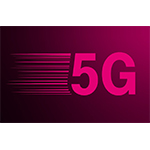 T-Mobile and Ericsson said they have demonstrated 5G speeds of more than 5.6 Gbps on one channel of 2.5 GHz spectrum. T-Mobile said that it will begin deploying the technology necessary to achieve these speeds next year.
T-Mobile and Ericsson said they have demonstrated 5G speeds of more than 5.6 Gbps on one channel of 2.5 GHz spectrum. T-Mobile said that it will begin deploying the technology necessary to achieve these speeds next year.
In the test, engineers connected eight smartphones to the same 5G radio and resources. Each of the smartphones – the OnePlus 8 5G — reached speeds of more than 700 Mbps. This was achieved via 16 unique streams of data that were transmitted, each hitting more than 350 Mbps. Each device received two of these streams.
Key to this performance is MU-MIMO, which T-Mobile described as “a fancy term for reusing the same radio resources for many users in the same cell at the same time” and beamforming, which was described as “focusing a wireless connection in a specific direction.”
Both the OnePlus 8 and the MIMO radio outfitted with 64 antennas from Ericsson used in the test are commercially available, T-Mobile said.
T-Mobile 5.6 Gbps
“In tech terms, with 100 MHz of total 5G spectrum in the demonstration, T-Mobile was able to achieve an astonishing 50+ bps/Hz in spectral efficiency,” the company said in a press release about the T-Mobile 5.6 Gbps demo. “That is much higher than the single digit efficiency typically experienced today.”
The demonstration on 2.5 GHz spectrum is important because T-Mobile, in the wake of its acquisition of Sprint, is expanding its service in this mid-band range significantly. Earlier this month, the company said that it now is serving 89 cities and towns with the mid-band. At that time, T-Mobile announced 81 new markets for the service, focused on smaller communities after earlier announcements focused on major metropolitan areas. The carrier also said that it was on track to light up 1,000 sites per month in the mid-band.
The expansion of speed in the mid-band is interesting because of CTO Neville Ray’s stated layer cake approach in which low frequency/ low bandwidth is used for coverage, high-frequency mmWave for peak speeds and mid-band for a tradeoff between the two. The question becomes how extensive the need will be for mmWave if the mid-band can operate at such high speeds.

